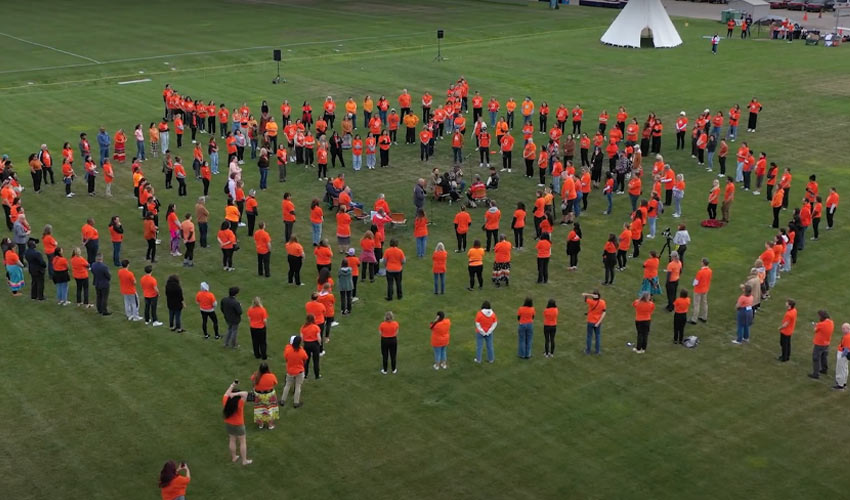Journey to Indigenization: Human spiderweb spreads interconnectedness
Physical representation of Ani to pisi (spiderweb) comes alive at MRU
— Mount Royal University | Posted: September 21, 2023 | Lasted updated: October 13, 2023
Elder Roy Bear Chief reads the story of Ani to pisi, explaining it comes from his late older brother Clement.
Ani to pisi (spiderweb) is a powerful creation story that comes from Elder Roy Bear Chief’s late older brother Clement.
It is relevant to institutions like Mount Royal University and is a foundational component of the Faculty of Health, Community and Education Strategic Plan.
“I came across it 18 or 19 years ago and I kept it. It laid dormant until I started working at Vibrant Communities Calgary,” said Bear Chief.
It was then that he decided to share the broader teaching implications that can come from it. The visual representation of Ani to pisi is a spiderweb “which speaks to the interrelatedness and interconnectedness” of society.
“It connects us all,” he explains. “It speaks to the idea that we all belong here regardless of who we are.”
Spiderwebs are strong, woven, interconnected silk strands. Spiders use the web to catch their prey. When something lands in their web they feel the vibrations and respond to them. Bear Chief says Ani to pisi teaches us to feel the vibrations and respond to them.
“If there’s problems anywhere on the web it will vibrate, and if you feel those vibrations, you are supposed to go and help.”
But it’s not just the negative vibrations Ani to pisi teaches us to respond to, according to Bear Chief.
“We need to celebrate good vibrations too. We are all one.”
Those vibrations were felt by hundreds on Thursday, Sept. 28 as Ani to pisi came to life in physical form.
Students, staff and faculty, who were all wearing orange t-shirts, joined together to create a human spiderweb as part of MRU’s Journey to Indigenization.

A drone captures the human spiderweb formed by students, staff and faculty.
The idea first came to Bear Chief when he was sitting in his south-facing office in the Bissett School of Business building.
“At lunch time I would close my door and look out the window. I saw the soccer fields out there and thought wouldn’t that be something if we could create a human spiderweb out there. But that was only an idea at that time.”
Bear Chief says it was at a meeting in the spring with some faculty members when he again brought the idea up.
“When I looked around the room and the people in attendance, I saw a sparkle in their eyes,” Bear Chief said, who knew then he had garnered some interest.
A few months later on a crisp fall day his vision came true. The event started on a somber note as John Fischer, interim AVP Indigenization and Decolonization acknowledged both the survivors and those who never came home from residential schools.
“Seeing everyone in orange shirts, honoring those who didn’t come home and also residential school survivors, was very powerful.”
After a territorial land acknowledgement and blessing by Elder Miiksika’am, Elder Bear Chief told the story of Ani to pisi to the crowd. Then, the strands started to move in a specific pattern and direction, all timed to the beating drums of the Sorrel Rider Singers.
After the spiderweb, participants joined hands for a final Round Dance that spanned the whole soccer field while the Elders remained in the middle.
Fischer says the Round Dance was a joyful demonstration of how people can come together.
“We started off with this heaviness, reflecting on the horrific realities caused by the residential school system. And then seeing everyone joined hand-in-hand dancing around the Elders and drummers was a beautiful representation of connection and reconciliation. The Elders were waving to everyone and smiling and you could feel the shift in energy.”
When asked to reflect on seeing the physical representation of Ani to pisi that day, this is what Elder Roy Bear Chief had to say:
I was once told that I like to colour outside the lines and the creation of a human spiderweb is an example of that.
When I got home from Mount Royal that day and sat in my recliner, I felt this accumulation of anxiety that had built up over the last month or so, leaving me while a rush took over my body.
I felt a rush as if it was a warm wind that passed over me.
It was then that I realized that we did it and we created a human spiderweb with its vibrations.
It is a testament to MRU’s commitment to reconciliation. The final piece to the whole process is that my brother, Clement, who passed away last February 2022 looking down on the human spiderweb and saying Sokapi which means “good” in Blackfoot. Sokapi is also a sign or stamp of approval.
That to me is the icing on the cake. Even though my brother is no longer here physically, his spirit was indeed present in the spiderweb.
To me, my brother was the ksawakasii (spider) who inspected the web to see that the strands are in working order and then he went back up for a birds-eye view.
With humbleness and gratitude to everyone that participated in making Ani to pisi come alive.
Reconciliation is really about the willingness to colour outside the lines.

